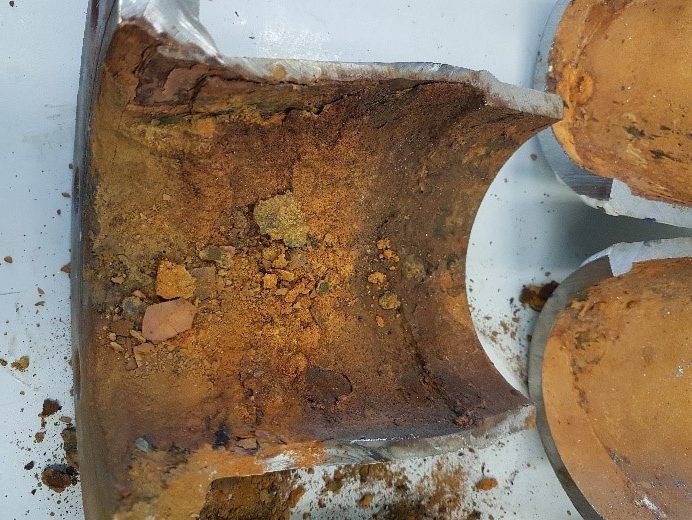Home » Case studies » Galvanic corrosion on an offshore patrol vessel
The shipyard requested a root cause analysis of the experienced failure of components.
On several patrol vessels, sections of pipe right adjacent to a heat exchanger were perforated an leaking. Inspection on the pipes of all heat exchangers showed heavy corrosion and indicated that similar perforations could occur.
Hot-dipped galvanized steel pipes right next to the stainless/titanium heat exchangers were perforated. The pipes are attached to the heat exchangers using a variety of materials: Steel, Stainless Steel and Titanium.
On-site inspection of the inside of the pipes showed heavy corrosion and indicated that similar perforations could occur. A full failure analysis package, including preparation of samples for optical microscopy, cross-cut examination and SEM-EDS was carried out to identify the root cause of damage and type of corrosion involved. Microbial analysis (MPN technique) was included in the investigation to assess the possible role of microbially induced corrosion (MIC).


Pipe samples analyzed in the laboratory showed a thick layer of corrosion products throughout the pipe (Figure 1). The pipe was cut into four sections with section 1 starting at the pipe/flange connection. Analysis showed a thick layer of corrosion products had formed throughout the interior of the pipe adjacent to the flange. As seen in Figure 2 internal pipe corrosion progressively diminishes as you move away from the flange.
Micro-organisms were found to be present but not active, and are therefore not involved in the corrosion mechanism. Corrosion products found on the inside of pipes are common for this type of steel. After removal of the corrosion layer the protective zinc layer that should be present was found to be missing on part of the pipe closest to the heat exchanger. On this part significant mass loss was observed. Furthermore corrosion pits were found not only close to the heat exchanger but throughout the whole pipe.
Based on the results of the analyses in our laboratory, visual inspection from other parts of pipe systems on board this ship and the review of materials used in this system it was concluded that the damage could be attributed to galvanic corrosion. Galvanic corrosion occurred due to the combined use of several metals and alloys which were electrically connected.
Based on this conclusion, the customer was advised to electrically insulate the steel pipe system from the stainless/titanium heat exchanger.